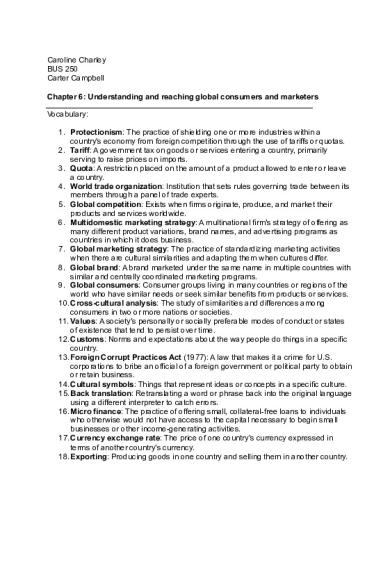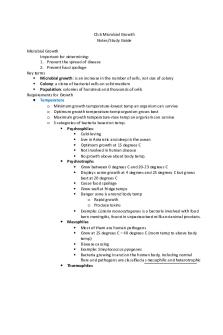BUS 250 Ch 6 notes - Profesor Carter PDF

| Title | BUS 250 Ch 6 notes - Profesor Carter |
|---|---|
| Author | Caroline Charley |
| Course | Marketing |
| Institution | Westminster College (Utah) |
| Pages | 3 |
| File Size | 77 KB |
| File Type | |
| Total Downloads | 113 |
| Total Views | 151 |
Summary
Profesor Carter ...
Description
Caroline Charley BUS 250 Carter Campbell Chapter 6: Understanding and reaching global consumers and marketers Vocabulary: 1. Protectionism: The practice of shielding one or more industries within a country's economy from foreign competition through the use of tariffs or quotas. 2. Tariff: A government tax on goods or services entering a country, primarily serving to raise prices on imports. 3. Quota: A restriction placed on the amount of a product allowed to enter or leave a country. 4. World trade organization: Institution that sets rules governing trade between its members through a panel of trade experts. 5. Global competition: Exists when firms originate, produce, and market their products and services worldwide. 6. Multidomestic marketing strategy: A multinational firm's strategy of offering as many different product variations, brand names, and advertising programs as countries in which it does business. 7. Global marketing strategy: The practice of standardizing marketing activities when there are cultural similarities and adapting them when cultures differ. 8. Global brand: A brand marketed under the same name in multiple countries with similar and centrally coordinated marketing programs. 9. Global consumers: Consumer groups living in many countries or regions of the world who have similar needs or seek similar benefits from products or services. 10. Cross-cultural analysis: The study of similarities and differences among consumers in two or more nations or societies. 11. Values: A society's personally or socially preferable modes of conduct or states of existence that tend to persist over time. 12. Customs: Norms and expectations about the way people do things in a specific country. 13. Foreign Corrupt Practices Act (1977): A law that makes it a crime for U.S. corporations to bribe an official of a foreign government or political party to obtain or retain business. 14. Cultural symbols: Things that represent ideas or concepts in a specific culture. 15. Back translation: Retranslating a word or phrase back into the original language using a different interpreter to catch errors. 16. Micro finance: The practice of offering small, collateral-free loans to individuals who otherwise would not have access to the capital necessary to begin small businesses or other income-generating activities. 17. Currency exchange rate: The price of one country's currency expressed in terms of another country's currency. 18. Exporting: Producing goods in one country and selling them in another country.
19. Joint venture: When a foreign company and a local firm invest together to create a local business, sharing ownership, control, and the profits of the new company. Questions: 1. What are the major trends that have influenced world trade and global marketing? There are four major trends have influenced the landscape of global marketing in the past decade. First, there has been a decline of economic protectionism by individual countries, leading to a reduction in tariffs and quotas. Second, there is growing economic integration and free trade among nations, reflected in the creation of the European Union and the North American Free Trade Agreement. Third, there exists global competition among global companies for global consumers, resulting in firms adopting global marketing strategies and promoting global brands. And finally, a networked global marketspace has emerged using Internet technology as a tool for exchanging goods, services, and information on a global scale. 2. What are the environmental forces that shape global marketing efforts? There are three major environmental forces shape global marketing efforts. First, there are cultural forces, including values, customs, cultural symbols, and language. Economic forces also shape global marketing efforts. These include a country's stage of economic development and economic infrastructure, consumer income and purchasing power, and currency exchange rates. Finally, politicalregulatory forces in a country or region of the world create a favorable or unfavorable climate for global marketing efforts. 3. What are the alternative approaches and how do companies use to enter global markets? Companies have four alternative approaches for entering global markets. These are exporting, licensing, joint ventures, and direct investment. Exporting involves producing goods in one country and selling them in another country. Under licensing, a company offers the right to a trademark, patent, trade secret, or similarly valued item of intellectual property in return for a royalty or fee. In a joint venture, a foreign company and a local firm invest together to create a local business. Direct investment entails a domestic firm actually investing in and owning a foreign subsidiary or division. 4. What is the distinction between standardization and customization when
companies craft worldwide marketing programs? Companies distinguish between standardization and customization when crafting worldwide marketing programs. Standardization means that all elements of the marketing program are the same across countries and cultures. Customization means that one or more elements of the marketing program are adapted to meet the needs or preferences of consumers in a particular country or culture. Global marketers apply a simple rule when crafting worldwide marketing programs: Standardize
marketing programs whenever possible and customize them wherever necessary....
Similar Free PDFs

Ch 6 - Lecture notes 6
- 3 Pages

Ch 6 - Lecture notes 6
- 4 Pages

Discussion Notes CH 6
- 2 Pages

CH 6 - Chapter Notes
- 13 Pages

Ch.6 Notes
- 3 Pages

Stats 250 Completed Notes
- 212 Pages

SOC 250 Notes
- 18 Pages

CH - 6 Axial FLOW - Lecture notes 6
- 49 Pages

Ch 6 review - Lecture notes 6
- 4 Pages

Ch 6 lecture notes/outline
- 7 Pages
Popular Institutions
- Tinajero National High School - Annex
- Politeknik Caltex Riau
- Yokohama City University
- SGT University
- University of Al-Qadisiyah
- Divine Word College of Vigan
- Techniek College Rotterdam
- Universidade de Santiago
- Universiti Teknologi MARA Cawangan Johor Kampus Pasir Gudang
- Poltekkes Kemenkes Yogyakarta
- Baguio City National High School
- Colegio san marcos
- preparatoria uno
- Centro de Bachillerato Tecnológico Industrial y de Servicios No. 107
- Dalian Maritime University
- Quang Trung Secondary School
- Colegio Tecnológico en Informática
- Corporación Regional de Educación Superior
- Grupo CEDVA
- Dar Al Uloom University
- Centro de Estudios Preuniversitarios de la Universidad Nacional de Ingeniería
- 上智大学
- Aakash International School, Nuna Majara
- San Felipe Neri Catholic School
- Kang Chiao International School - New Taipei City
- Misamis Occidental National High School
- Institución Educativa Escuela Normal Juan Ladrilleros
- Kolehiyo ng Pantukan
- Batanes State College
- Instituto Continental
- Sekolah Menengah Kejuruan Kesehatan Kaltara (Tarakan)
- Colegio de La Inmaculada Concepcion - Cebu





